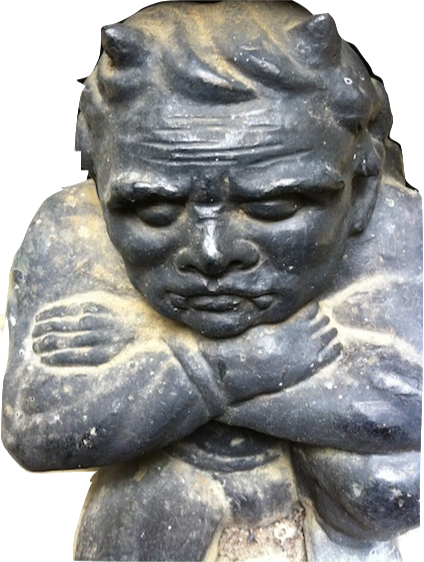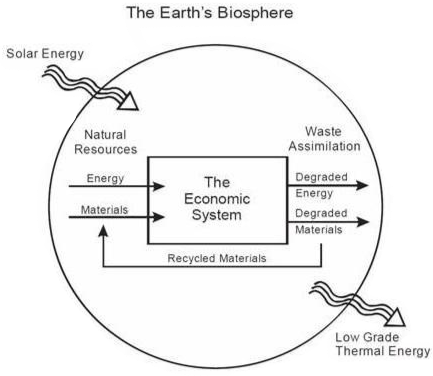定常型経済
Steady-state economy

定常型経済
Steady-state economy

「利益率の低下は繁栄がもたらす自然な結果であり、産業に投じられる資本が増加したことの自然な結果である」——アダム・スミス「ストックの利益について」(第1編9章『国富論』)
"A steady-state economy is an economy made up of a constant stock of physical wealth (capital) and a constant population size. In effect, such an economy does not grow in the course of time.[1]:366–369 [2]:545 The term usually refers to the national economy of a particular country, but it is also applicable to the economic system of a city, a region, or the entire world. Early in the history of economic thought, classical economist Adam Smith of the 18th century developed the concept of a stationary state of an economy: Smith believed that any national economy in the world would sooner or later settle in a final state of stationarity.[3]:78 Since the 1970s, the concept of a steady-state economy has been associated mainly with the work of leading ecological economist Herman Daly.[4]:303 [5]:32f [6]:85 As Daly's concept of a steady-state includes the ecological analysis of natural resource flows through the economy, his concept differs from the original classical concept of a stationary state. One other difference is that Daly recommends immediate political action to establish the steady-state economy by imposing permanent government restrictions on all resource use, whereas economists of the classical period believed that the final stationary state of any economy would evolve by itself without any government intervention.[7]:295f[8]:55f The world's mounting ecological problems have brought about a widening interest in the concept of a steady-state economy. Critics of the steady-state economy usually object to it by arguing that resource decoupling, technological development, and the unrestrained operation of market mechanisms are capable of overcoming any resource scarcity, any rampant pollution, or population overshoot. Proponents of the steady-state economy, on the other hand, maintain that these objections remain insubstantial and mistaken — and that the need for a steady-state economy is becoming more compelling every day.[9][10][11][6]:148–155 A steady-state economy is not to be confused with economic stagnation: Whereas a steady-state economy is established as the result of deliberate political action, economic stagnation is the unexpected and unwelcome failure of a growth economy. An ideological contrast to the steady-state economy is formed by the concept of a post-scarcity economy."
"Post-scarcity
is a theoretical economic situation in which most goods can be produced
in great abundance with minimal human labor needed, so that they become
available to all very cheaply or even freely.[1][2] Post-scarcity does
not mean that scarcity has been eliminated for all goods and services,
but that all people can easily have their basic survival needs met
along with some significant proportion of their desires for goods and
services.[3] Writers on the topic often emphasize that some commodities
will remain scarce in a post-scarcity society.[4][5][6][7]" - Post-scarcity economy.

【テキス ト】広井良典、2001『定常型社会:新しい「豊かさ」の構想 』岩波新書、東京:岩波書店 以下【章立て】
【定常型社会の定義】
経済的成長を至上目的としない社会、(突き詰めて言えば)ゼロ成長社会のこと。
【著者じしんの言葉に耳を傾けましょう】
「閉塞感が現在の日本社会をあらゆる局面において覆っている、ということはあらためて言うま でもないことだろう。 そうした閉塞感の背景のひとつには、たとえば高齢化の中で年金制度が破綻するとか、医療費や介護の負担で経済が失速する等といった、社会保障制度の将来に 対する不安というものがある。 しかしより根底的には、戦後の、あるいは明治期以来の日本が一貫して追求してきた「(経済)成長」ないし「物質的な富の拡大」という目標がもはや目標とし て機能しなくなった今という時代において、それに代わる新たな目標や価値を日本社会がなお見出しえないでいる、というところに閉塞感の根本理由があるよう に思われる。
では、私たちがこれから迎えようとしている社会あるいは時代は、いったいどのようなイメ− ジのものとして描きうるのだろうか。 ここで筆者が問題提起の意味を含めてまず提案したいのは、「定常型社会」という基本コンセプトである。 「定常型社会」とは、さしあたり単純に述べるならば、「(経済)成長」ということを絶対的な目標としなくとも十分な豊かさが実現されていく社会ということ であり、「ゼロ成長」社会といってもよい。 これからの日本社会の本質は、まずもってこの「定常型社会」ということに集約されると筆者は考えている。
なぜ「定常型社会」なのか? 基本的には、経済成長の究極の源泉である需要そのものが成熟 ないし飽和状態に達しつつある、ということであるが、関連する重要な要因として次の2点がある。
第一は、高齢化ないし少子化という動きと不可分のものとして、人口そのものが2007年を ピ−クに減少に転じるということである。 このこと自体、明治期以来わが国が百数十年ぶりに初めて経験する現象だ。 第二は、環境問題との関係である。資源や自然環境の有限性が自覚されるようになり、経済活動それ自体の持続性ということを考えても、経済の規模の「定常 性」が“要請”されるようになった。 このように、定常型社会とは実は「高齢化社会」と「環境親和型社会」というふたつを結びつけるコンセプトでもある。
さて、「成長」や「拡大」ではなく「定常型社会」ということを基本的な出発点とすると、私 たちは多くのドグマや混乱から解放される。 逆に言うと、「成長し続けなければならない」という大前提にとらわれているために、私たちはいかに多くのものを失い、また無用の落胆をし犠牲を出している だろうか。 ムダとしか思えないような公共事業や、それに伴ってどんどんツケとして回される将来世代への負担の話は言うまでもないし、もともと近年の不況も源をたどれ ばバブル期において需要の実体がないところにマネ−志向だけが拡大を続けたことが大きい。 定常型社会ということを社会のコンセンサスとすることで、私たちは多くの意味のない政策から自由になることができるし、より重要なこととして、まったく新 しいこれからの社会像や価値がそこに開けてくるのである。」
出典:http: //www.iwanami.co.jp/moreinfo/4307330/top2.html(March 10,2004)
リンク
文献
その他の情報
【宿題】
審問1:著者の経済成長に対する考え方を、これまで言われてきた経済学の用語を用いて解 釈し なさい
審問2:広井の社会改革プランを実現するためには、政府・共同体・個人はなにをおこなう べき なのか、彼の議論から敷衍して推論できることを述べなさい。
審問3:広井は本書より後に「持続可能な福祉社会」(日経新聞、20040309「年金 より も医療・福祉」(経済教室))を主張するようになるが、これは『定常型社会』で論じられていることと、いかなる点で共通点をもつのか、またいかなる点で相 違点をもつのだろうか? それらを簡潔に明らかにしなさい。